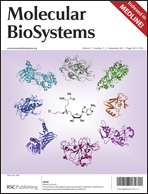A composite feed-forward loop I4-FFL involving IHF and Crc stabilizes expression of the XylR regulator of Pseudomonas putidamt-2 from growth phase perturbations
Abstract
Genetic networks are typically composed of a series of connected motifs that confer specific logic and dynamic properties to the resulting circuits. While some feed forward loop (FFL) variants abound in such networks, others (e.g. the type-4 incoherent FFL or I4-FFL) are virtually absent from the known regulatory devices. We report here that the key node that rules the expression of the m-xylene biodegradation pathway of the soil bacterium Pseudomonas putidamt-2 merges opposite physiological effects of the growth phase by means of a regulatory device based on the rarely found I4-FFL motif. Specifically, the FFL includes the integration host factor (IHF), which both co-activates the master Pu promoter and represses transcription of its cognate regulatory gene xylR at the onset of the stationary phase. On the other hand, the catabolite repression control (Crc)


 Please wait while we load your content...
Please wait while we load your content...